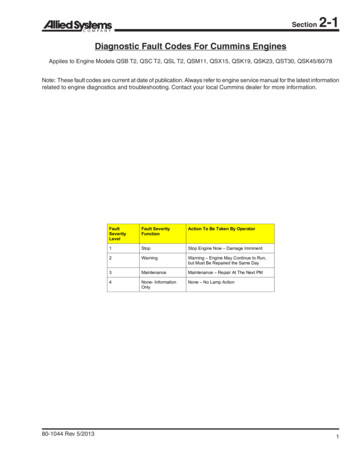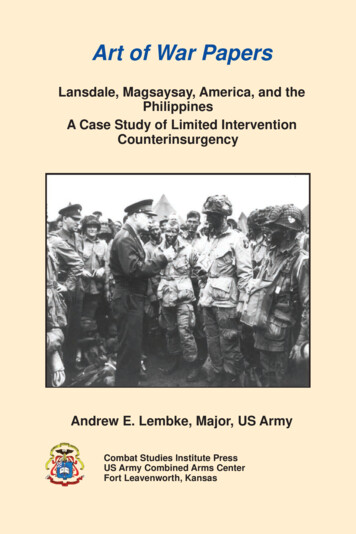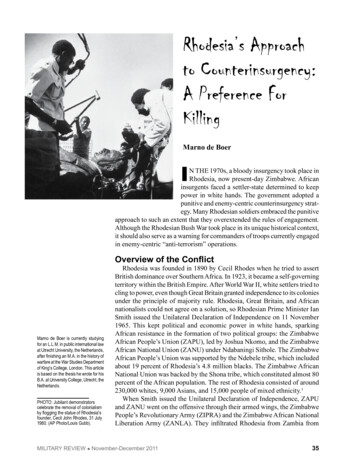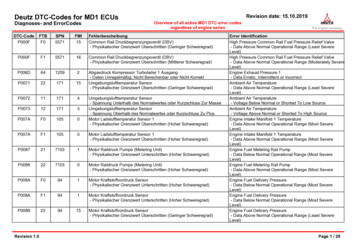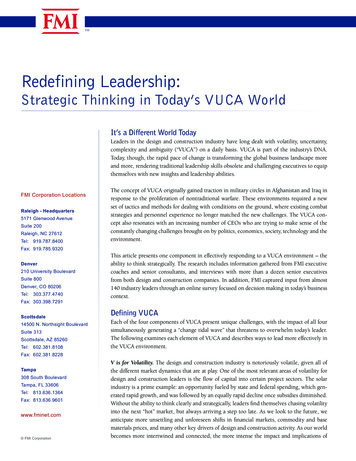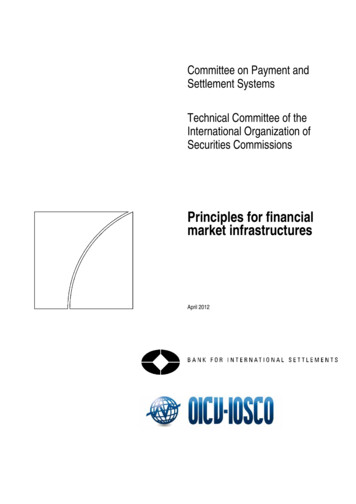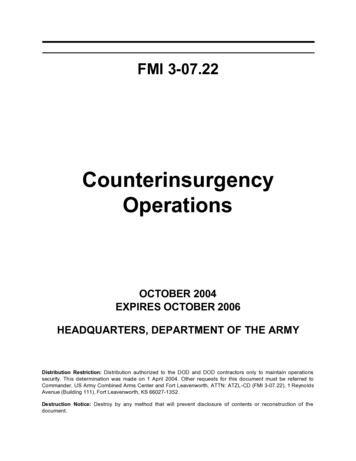
Transcription
FMI 3-07.22CounterinsurgencyOperationsOCTOBER 2004EXPIRES OCTOBER 2006HEADQUARTERS, DEPARTMENT OF THE ARMYDistribution Restriction: Distribution authorized to the DOD and DOD contractors only to maintain operationssecurity. This determination was made on 1 April 2004. Other requests for this document must be referred toCommander, US Army Combined Arms Center and Fort Leavenworth, ATTN: ATZL-CD (FMI 3-07.22), 1 ReynoldsAvenue (Building 111), Fort Leavenworth, KS 66027-1352.Destruction Notice: Destroy by any method that will prevent disclosure of contents or reconstruction of thedocument.
This publication is available atArmy Knowledge Onlinewww.us.army.mil
*FMI 3-07.22Field Manual–InterimNo. 3-07.22HeadquartersDepartment of the ArmyWashington, DC, 1 October 2004Expires 1 October 2006Counterinsurgency OperationsContentsPagePREFACE .ivINTRODUCTION .viChapter 1OVERVIEW . 1-1Definition of Insurgency. 1-1Elements of the Insurgency. 1-1Origins and Causes . 1-3Insurgent Doctrine . 1-5Dynamics of Insurgency . 1-7State Approach to Insurgency . 1-9Chapter 2COMMAND AND CONTROL IN A COUNTERINSURGENCY ENVIRONMENT2-1Section I – Introduction. 2-1General . 2-1Fundamental Conditions . 2-2Section II – Role of the Army in Counterinsurgency . 2-3Section III – Planning Consideration for Counterinsurgency. 2-4Mission Analysis . 2-4Intelligence Estimate . 2-4Civil-Military Operations Estimate . 2-5Section IV – Command and Control . 2-6Command and Control of Counterinsurgency Forces. 2-6Army Special Operations Forces. 2-7Multinational Forces . 2-9Section V – Coordination. 2-10Interagency Coordination . 2-10Coordination with Host-Nation Civil Authorities. 2-11Coordinating Structures. 2-12Civil-Military Operations Center. 2-13Distribution Restriction: Distribution authorized to the DOD and DOD contractors only to maintain operationssecurity. This determination was made on 1 April 2004. Other requests for this document must be referred toCommander, US Army Combined Arms Center and Fort Leavenworth, ATTN: ATZL-CD (FMI 3-07.22), 1 Reynolds Avenue (Building 111), Fort Leavenworth, KS 66027-1352.Destruction Notice: Destroy by any method that will prevent disclosure of contents or reconstruction of thedocument.i
FMI 3-07.22Section VI – Rules of Engagement.2-13Section VII – Civil-Military Operations Mission Planning and Criteria ofSuccess.2-15Section VIII – Other Planning Considerations .2-16Planning for Public Affairs and Media Teams.2-16Use of Interpreters .2-17Chapter 3COUNTERINSURGENCY OPERATIONS .3-1Section I – Concept of Operations .3-1General .3-1Command and Control.3-1Resource Allocation .3-2Section II – Civil-Military Operations.3-2General .3-2Population and Resource Control.3-2Control Program Phases.3-3Section III – Counterinsurgency Combat Operations .3-8Objectives .3-8Intelligence .3-8Host-Nation Security Force Operations .3-8Offensive Operations .3-8Defensive Operations .3-10Clear and Hold .3-11Section IV – Information Operations.3-14Information-Environment-Based Threats.3-14Information Operations in Support of Counterinsurgency .3-16Application of IO Elements In Counterinsurgency Support .3-18Section V – The Media .3-18Chapter 4INTELLIGENCE.4-1General .4-1Intelligence Preparation of the Battlefield Planning Considerations.4-2Intelligence Preparation of the Battlefield Assessment .4-5The Threat.4-8Types of Intelligence Support .4-12ISR Planning in Counterinsurgency Operations .4-16Chapter 5PSYCHOLOGICAL OPERATIONS AND MILITARY POLICE SUPPORT.5-1General .5-1Section I – Psychological Operations.5-1Mission Of Psycohological Operations .5-1Tactical Psychological Operations.5-2Tactical Psychological Operations Team.5-2Advising the Supported Commander.5-3Loudspeaker Operations.5-3Printed Products .5-3Face-To-Face Communications .5-4Pretesting and Posttesting .5-4Town and Area Assessments .5-4Radio and Television Station Assessments.5-4Civil Disturbance .5-4Propaganda Assessments and Counterpropaganda .5-4Psycohological Operations Considerations .5-5ii
ContentsSection II – Military Police . 5-5Maneuver and Mobility Support Operations. 5-5Area Security . 5-6Police Intelligence Operations. 5-6Law and Order Operations . 5-6Internment and Resettlement Operations . 5-7Detainee Operations . 5-7USA Criminal Investigation Division Command . 5-7Military Working Dogs . 5-7Chapter 6HEALTH CONSIDERATIONS, MOVEMENT SECURITY, AND CIVILDISTURBANCES . 6-1General . 6-1Section I – Health Service Support Considerations . 6-1Section II – Security During Movements. 6-2Convoy Operations. 6-2Vehicle Hardening Procedures. 6-5Vehicle Weapon Improvements . 6-6Section III – Civil Disturbance Measures . 6-9Threat Analysis. 6-10Crowd Characteristics . 6-10Types of Resisters. 6-12Tactical PSYOP Teams. 6-12Elements of a Control Force Formation . 6-13Control Force Formations. 6-15Vehicles and Formations. 6-18Crowd Control. 6-18Section IV – NonLethal Equipment and Weapons . 6-20Appendix ACIVIL-MILITARY OPERATIONS ASSESSMENT CHECKLIST .A-1Appendix BUSE OF INTERPRETERS .B-1Appendix CPOPULATION AND RESOURCES CONTROL .C-1Appendix DORDER OF BATTLE FACTORS.D-1Appendix EINTELLIGENCE INDICATORS. E-1Appendix FINTELLIGENCE ANALYSIS TOOLS AND INDICATORS. F-1Appendix GLEADER CHECKLIST FOR HEALTH SERVICE SUPPORT AND PREVENTIVEMEDICINE .G-1Appendix HMEDICAL EVACUATION .H-1Appendix IPLANNING FOR DETAINEE OPERATIONS AND FIELD PROCESSING OFDETAINEES . I-1Appendix JLEGAL CONSIDERATIONS IN COUNTERINSURGENCY. J-1GLOSSARY .Glossary-1BIBLIOGRAPHY . Bibliography-1iii
PrefacePURPOSEThis FMI establishes doctrine (fundamental principles and TTP) for military operations in acounterinsurgency environment. It is based on existing doctrine and lessons learned from recentcombat operations. Additional counterinsurgency doctrine is being developed. It will be combinedwith the doctrine in this FMI and published as an FM prior to October 2006. Send any commentsto the Combined Arms Center at Fort Leavenworth per instructions in the proponent statementbelow.SCOPETo make this text useful to leaders involved in counterinsurgency operations regardless of wherethese operations may occur, the doctrine contained herein is broad in scope and involves principles applicable to various AOs. This FMI is not focused on any region or country. Insurgencieshave some common characteristics, but their ideological basis may vary widely. Fundamental toall counterinsurgencies is the need to help local authorities establish safety, security, and stability, because insurgents thrive on chaos and instability.APPLICABILITYThe primary audience for this manual is conventional-force leaders at division-level and below.It supports Army Education System instruction on the theory and conduct of counterinsurgencyoperations.DESCRIPTION OF FIELD MANUALS–INTERIMAn FMI is a DA publication that provides expedited delivery of urgently needed doctrine the proponent has approved for use without placing it through the standard development process.Unless an FMI is rescinded, information it disseminates is incorporated into a new or revisedFM. FMIs expire after two years, unless superseded or rescinded.ADMINISTRATIVE INSTRUCTIONSThis publication uses the term insurgent to describe those taking part in any activity designed toundermine or to overthrow the established authorities.In the text, terms that have joint or Army definitions are italicized and the number of the proponent manual follows the definition. FMI 3-07.22 is not the proponent manual for any terms.President refers to the President and the Secretary of Defense, or their duly deputized alternatesand successors.Headquarters, US Army Training and Doctrine Command is the proponent for this publication.The preparing agency is the Combined Arms Doctrine Directorate, US Army Combined ArmsCenter. Send written comments and recommendations on DA Form 2028 (RecommendedChanges to Publications and Blank Forms) directly to: Commander, US Army Combined ArmsCenter and Fort Leavenworth, ATTN: ATZL-CD (FMI 3-07.22), 1 Reynolds Avenue (Buildingiv
Preface111), Fort Leavenworth, KS 66027-1352. Send comments and recommendations by e-mail toweb-cadd@leavenworth.army.mil. Follow the DA Form 2028 format or submit an electronic DAForm 2028.v
IntroductionBACKGROUNDThe American way of war includes mass, power, and the use of sophisticated smart weapons.However, large main force engagements that characterized conflict in World War II, Korea, andOperations Desert Storm and Iraqi Freedom in the Middle East have become the exceptions inAmerican warfare. Since the American Revolution, the Army has conducted stability operations,which have included counterinsurgency operations. Over the past half-century alone, the Armygained considerable experience in fighting insurgents in Southeast Asia (Vietnam, Laos, Philippines), Latin America (Colombia, Peru, El Salvador, Guatemala, Nicaragua), Africa (Somalia),Southwest Asia (Afghanistan), and now the Middle East (Iraq). Dealing with counterinsurgencysince the Vietnam War has fallen largely on SOF; however, conventional forces have frequentlycome into contact with insurgent forces that seek to neutralize the inherent advantages of size,weaponry, and conventional force TTP. Insurgents use a combination of actions that include terror, assassination, kidnapping, murder, guerrilla tactics such as ambushes, booby traps, and improvised explosive devices aimed at US and multinational forces, the host country’s leaders, andordinary citizens.The stunning victory over Saddam Hussein’s army in 2003 validated US conventional force TTP,but the ensuing aftermath of instability has caused review of lessons from the Army’s historicalexperience and those of the other services and multinational partners. One of the key recurringlessons is that the United States cannot win other countries’ wars for them, but can certainlyhelp legitimate foreign governments overcome attempts to overthrow them. US forces can assista country confronted by an insurgency by providing a safe and secure environment at the locallevel and continuously building on the incremental success.The impetus for this FMI came from the Iraq insurgency and the realization that engagementsin the Global War on Terrorism (GWOT) would likely use counterinsurgency TTPs. Consequently this FMI reviews what we know about counterinsurgency and explains the fundamentals of military operations in a counterinsurgency environment.COUNTERINSURGENCY DESCRIPTIONCounterinsurgency is those military, paramilitary, political, economic, psychological, and civicactions taken by a government to defeat insurgency (JP 1-02). It is an offensive approach involving all elements of national power; it can take place across the range of operations and spectrumof conflict. It supports and influences an HN’s IDAD program. It includes strategic and operational planning; intelligence development and analysis; training; materiel, technical, and organizational assistance; advice; infrastructure development; tactical-level operations; and many elements of PSYOP. Generally, the preferred methods of support are through assistance anddevelopment programs. Leaders must consider the roles of military, intelligence, diplomatic, lawenforcement, information, finance, and economic elements (MIDLIFE) in counterinsurgency.vi
IntroductionTYPES OF SUPPORTIndirect support emphasizes the principles of HN self-sufficiency and builds strong national infrastructures through economic and military capabilities. It includes security assistance, jointand multinational exercises, and exchange programs.Direct support (not involving combat operations) involves the use of US forces providing directassistance to the HN civilian populace or military. These are joint-or service-funded, do not usually involve the transfer of arms and equipment, and do not usually include training local military forces. Direct support (not involving combat operations) includes civil-military operations,intelligence and communications sharing, and logistics.Direct support (involving combat operations) introduces the use of US combat forces into counterinsurgency operations. The use of combat forces is a presidential decision and serves only as atemporary or provisional solution until HN forces are able to stabilize the situation and providesecurity for the populace.COUNTERINSURGENCY RESPONSIBILITIESRegional combatant commanders are responsible for conducting (planning, preparing, executing,and assessing) military operations in their areas of responsibility in support of counterinsurgency. Close coordination with the US ambassador or diplomatic representative and countryteam within supported HNs is essential in order to build an effective regional counterinsurgencyprogram.PLANNING IMPERATIVESCommanders consider longer-term strategic and operational effects of all US assistance effortsbefore executing counterinsurgency operations. They tailor military support of counterinsurgency operations to the environment and the specific needs of the supported HN and understandthat a basic premise of counterinsurgency is that the ultimate responsibility rests with the HN.Regional combatant commanders may develop theater strategies or campaign plans that supportthe CJCS taskings. Regardless of how commanders may tailor the planning process, militaryactivities in support of counterinsurgency requirements are integrated into concepts and plansat the operational and tactical levels.COUNTERINSURGENCY PLANNING PROCEDURES ANDCONSIDERATIONSCounterinsurgency operations are often conducted in a joint environment. Army commandersand leaders should be familiar with joint planning procedures.The five phases of joint deliberate planning procedures and considerations are initiation, conceptdevelopment and review, plan development, plan review, and supporting plans. The initiationphase begins with the combatant commander’s receipt of planning guidance from CJCS. Conceptdevelopment and review includes a mission analysis that looks at threats to HN stability; theHN social, economic, and political environment; analysis of assigned tasks; and development of amission statement. Plan development includes coordination with the US ambassador and country team as well as understanding legal authorizations, and restrictions. Planning considerations include HN sovereignty and legitimacy, third-country interests, use of force, long-termplanning, maximizing intelligence capability, unity of effort, tailoring counterinsurgency operations to the needs and environment of the HN, ROE, economy of force measures, and criteria ofsuccess. Plan review entails coordination with senior, subordinate, and adjacent commands, andsupporting agencies (USAID, CIA, and others). Supporting plans are then developed by theagencies and organizations mentioned in the plan. These supporting plans include a greaterlevel of detail and focus on how and when the support is provided. Several areas deserve specialvii
FMI 3-07.22attention when discussing employment of forces in counterinsurgency operations: cultural expertise, intelligence support; psychological impact; SOF; public information programs; logistic support; operations security, and, lessons learned.DIRECT OPERATIONSThe primary mission for combatant commanders and other joint force commanders is to preparefor war and, if engaged in war, to terminate it on terms favorable to the United States. Commanders consider the use of SOF when employing combat forces in support of counterinsurgency. Other considerations are maintaining close coordination with the HN IDAD organization;establishing transition points; maintaining a joint, interagency and multinational focus; identifying and integrating intelligence, logistics, and other combat support means in US combat operations; conducting offensive operations when necessary to protect personnel and resources, orto restore or establish order; reviewing human rights considerations; following the ROE; preventing indiscriminate use of force; maintaining the US interagency intelligence network; andintegrating with other counterinsurgency programs. The command and control relationships established for the combat operation will be modified based on the political, social, and militaryenvironment of the area. Sustainment of US forces is essential to success. Political sensitivitiesand concerns for HN legitimacy and minimum US presence change the complexion of sustainingoperations in the counterinsurgency environment.There are three direct operations critical to supporting counterinsurgency: CMO, combat operations, and IO. CMO span a very broad area in counterinsurgency and include activities such ascivil affairs, PSYOP, humanitarian assistance, support to civil administration, and military civicaction across the range of military operations. Using CMO to support military activities in acounterinsurgency program enhances preventive measures, reconstruction efforts, and combatoperations in support of efforts to stabilize and rebuild a HN. Combat operations are developedto neutralize the insurgent and, together with population and resources control measures, establish an environment within which political, social, and economic progress is possible. IO integrate all aspects of information to support and enhance the elements of combat power, with thegoal of dominating the battlespace at the right time, at the right place, and with the right weapons or resources.TRAININGTraining of HN forces must be consistent with national goals. Leaders ensure that individualsand units training HN forces receive instruction in the following: area and cultural orientation;language training; standards of conduct; integration of intelligence development, collection, andanalysis to support counterinsurgency programs; coordinating relationships and actions withother US government agencies; legal guidelines; ROE; and tactical-level force protection training. Training must prepare HN forces for military operations, to include institutional and unittraining. The training must also be designed to support a mix of personnel ranging from language-trained and culturally focused SOF to those totally untrained in the specific area wherethe counterinsurgency program is executed.END STATE AND CRITERIA OF SUCCESSCounterinsurgency missions must achieve the end state established by the President. All leaderskeep in mind the purpose of their operations and the criteria of success used to assess them.Achieving success in counterinsurgency operations involves accomplishing the following tasks: Protect the population. Establish local political institutions. Reinforce local governments. Eliminate insurgent capabilities. Exploit information from local sources.viii
Chapter 1OverviewDEFINITION OF INSURGENCY1-1. An insurgency is organized movement aimed at the overthrow of a constituted government through use of subversion and armed conflict (JP 1-02). It is a protracted politicomilitary struggle designed to weaken government control and legitimacy while increasinginsurgent control. Political power is the central issue in an insurgency.1-2. Each insurgency has its own unique characteristics based on its strategic objectives, itsoperational environment, available resources, operational method, and tactics (For example,an insurgency may be based on mass mobilization through political action or the FOCO theory. Insurgencies frequently seek to overthrow the existing social order and reallocate powerwithin the country.1-3. The goal of an insurgency is to mobilize human and material resources in order to forman alternative to the state. This alternative is called the counterstate. The counterstate mayhave much of the infrastructure possessed by the state itself, but this must normally be hidden, since it is illegal. Thus the counterstate is often referred to by the term “clandestine infrastructure.” As the insurgents gain confidence and power, the clandestine infrastructuremay become more open, as observed historically in communist regions during the ChineseRevolution, in South Vietnam after the North Vietnamese 1972 Easter Offensive, and in Colombia in the summer of 1998.1-4. Successful mobilization provides active and passive support for the insurgency’s programs, operations, and goals. At the national level, mobilization grows out of dissatisfactionby some elite members with existing political, economic, or social conditions. At the regionallevel, members of an elite have become marginalized (that is, they have become psychologically alienated from the system), and have established links with followers by bringing theminto the counterstate. At the local, district and province-levels, local movement representatives called the cadre address local grievances and do recruiting. The cadre gives credit tothe insurgent movement for all local solutions. Loyalty to the insurgent movement is normally won through deeds but may occur through appeal to abstract principles. Promises toend hunger or eliminate poverty may appeal to a segment of the population, while appeals toeliminate a foreign presence or establish a government based on religious or political ideology may appeal to others. Nonetheless, these promises and appeals are associated with tangible solutions and deeds.ELEMENTS OF THE INSURGENCY1-5. An insurgent organization normally consists of four elements:Leadership.Combatants (main forces, regional forces, local forces).Cadre (local political leaders that are also called the militants).Mass base (the bulk of the membership).1-1
FMI 3-07.22The proportions relative to the larger movement depend upon the strategic approachadopted by the insurgency. To the extent state p
FMI 3-07.22 is not the proponent manual for any terms. President refers to the President and the Secretary of Defense, or their duly deputized alternates and successors. Headquarters, US Army Training and Doctrine Command is the proponent for this publication. The preparing agency is the Combined Arms Doctrine Directorate, US Army Combined Arms
